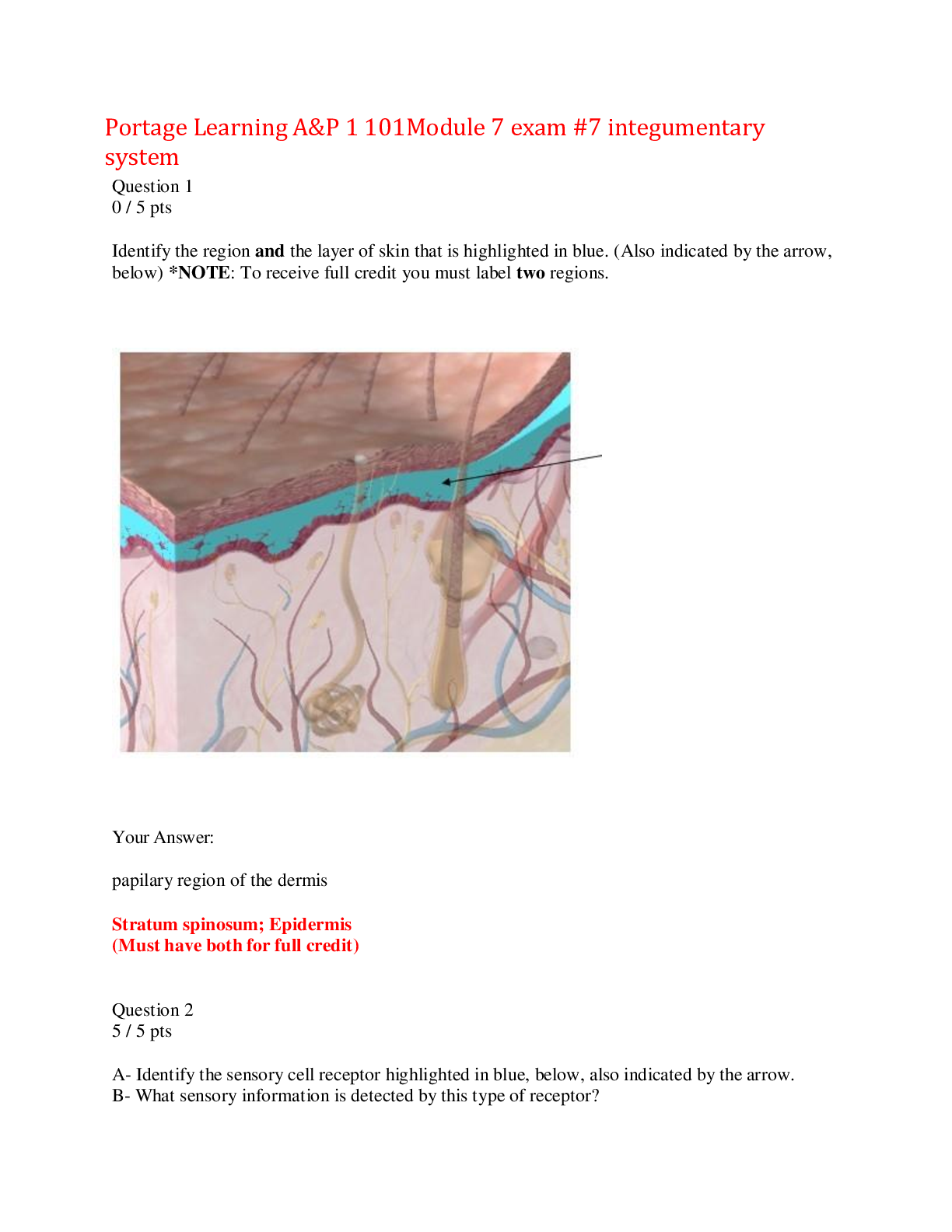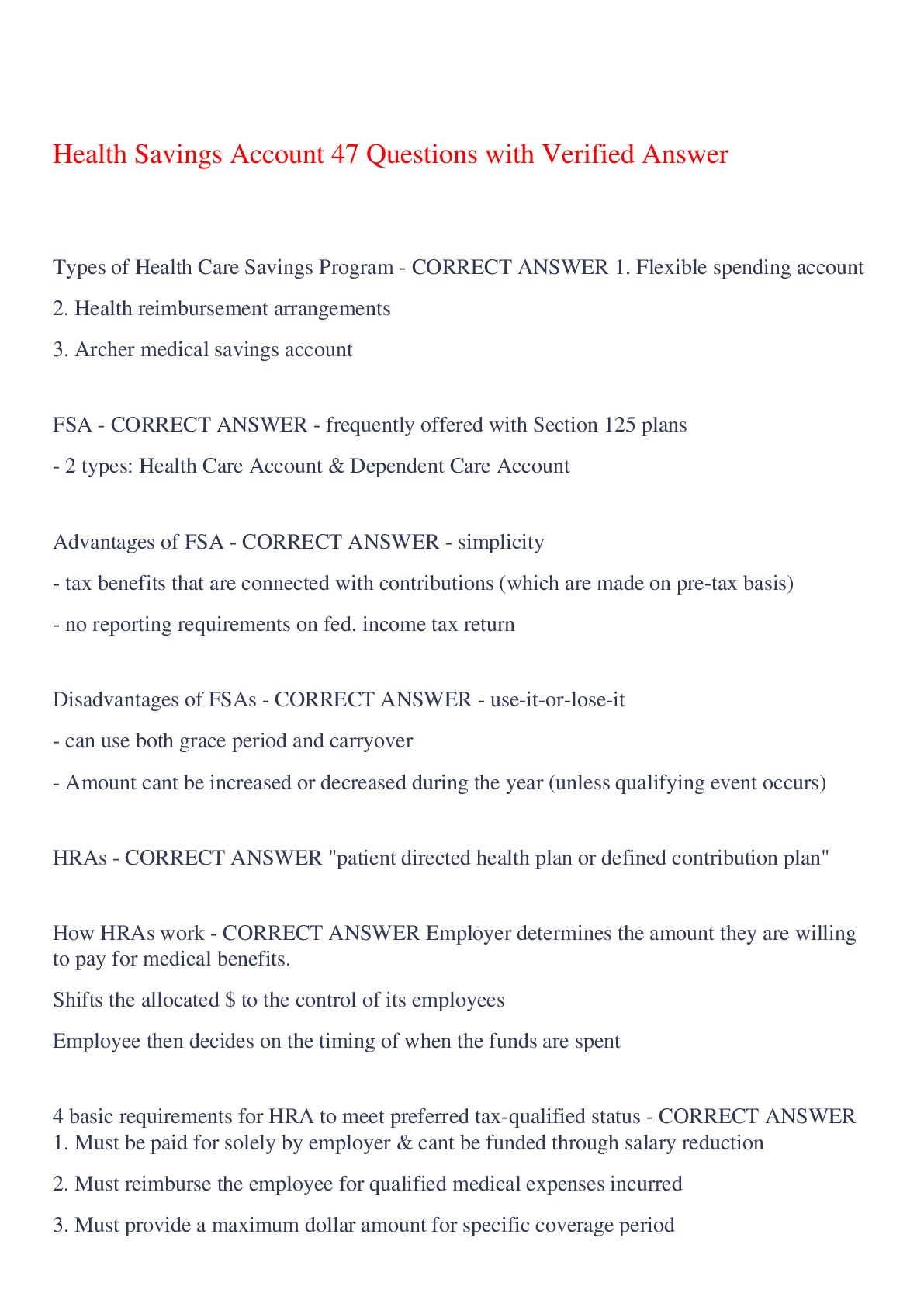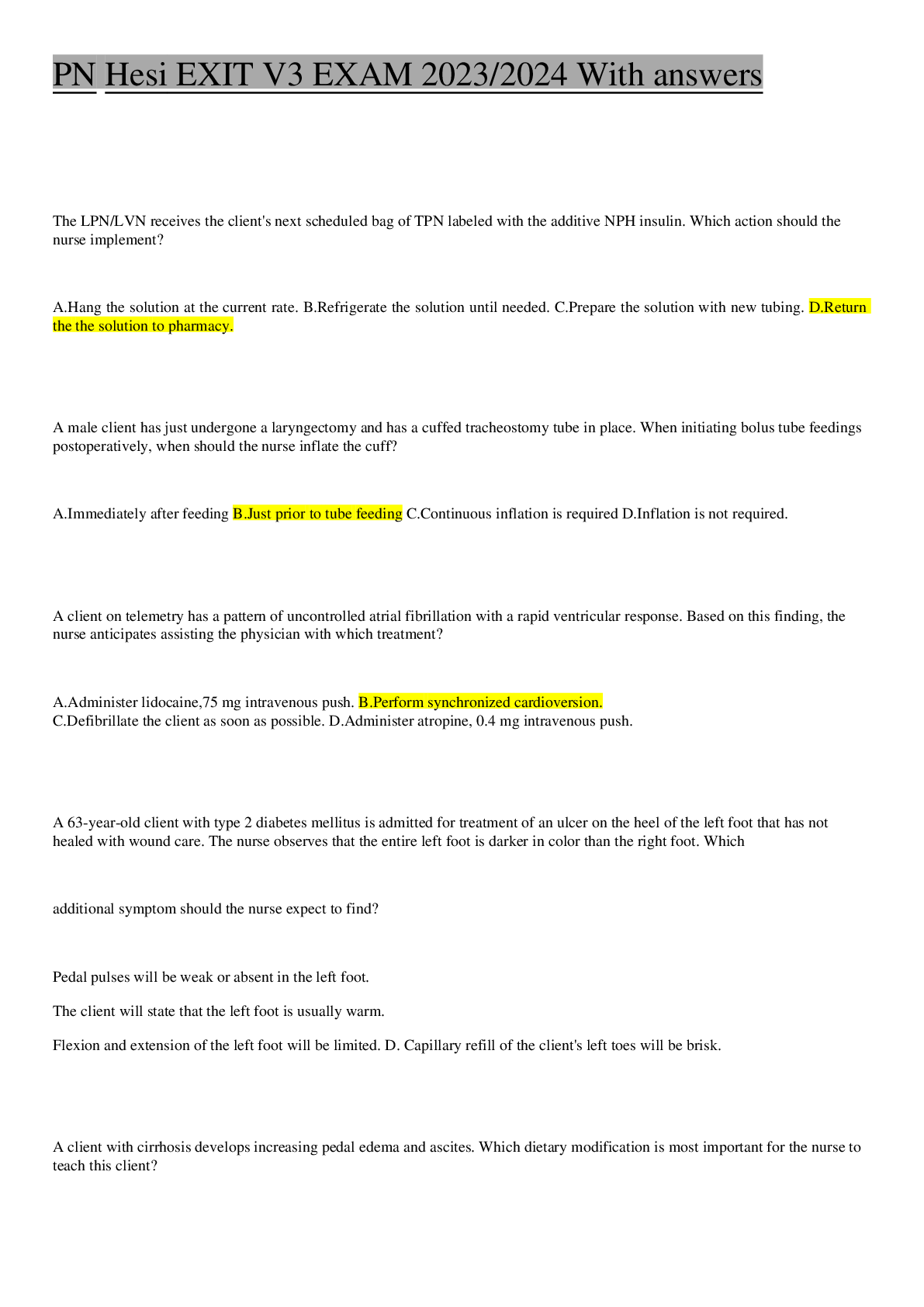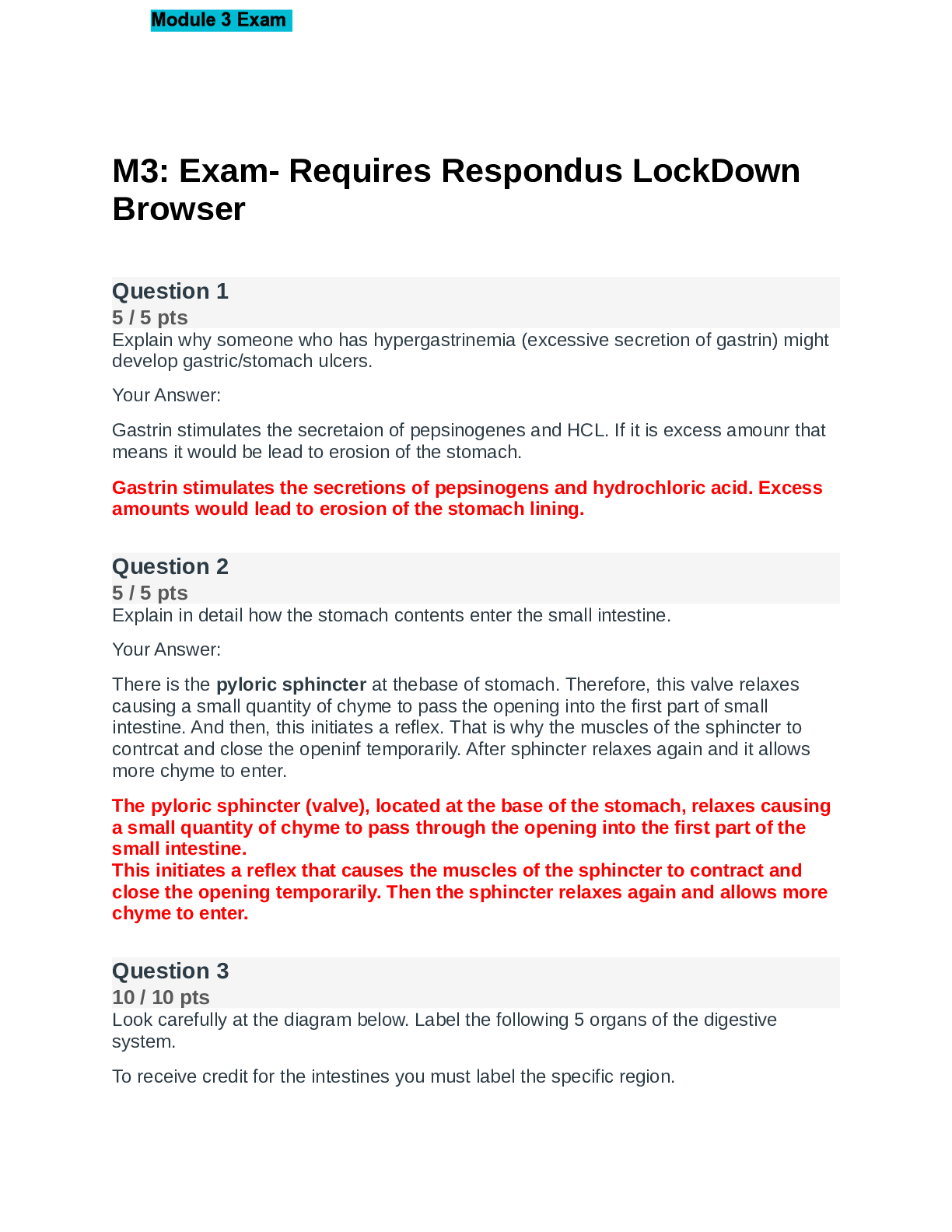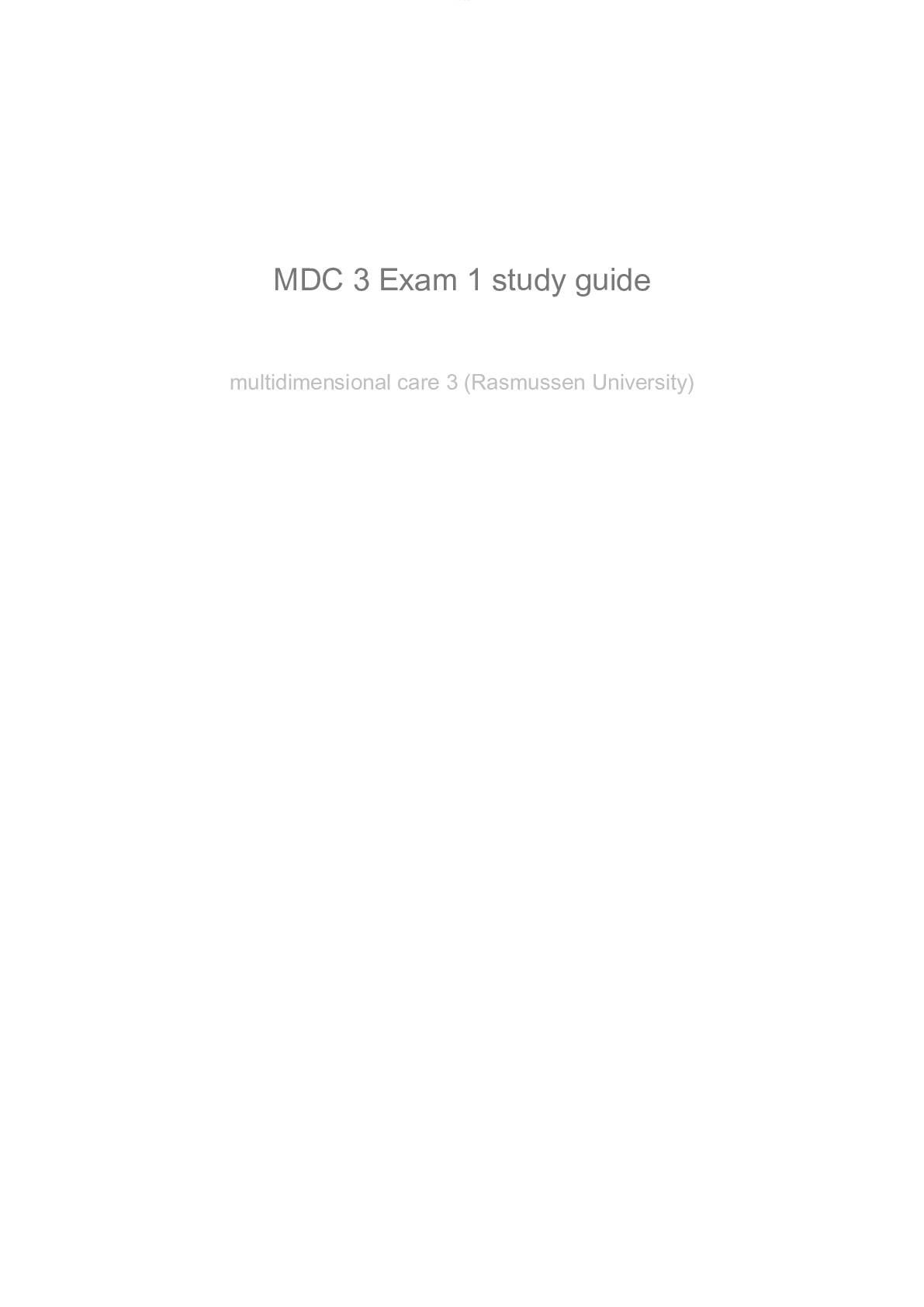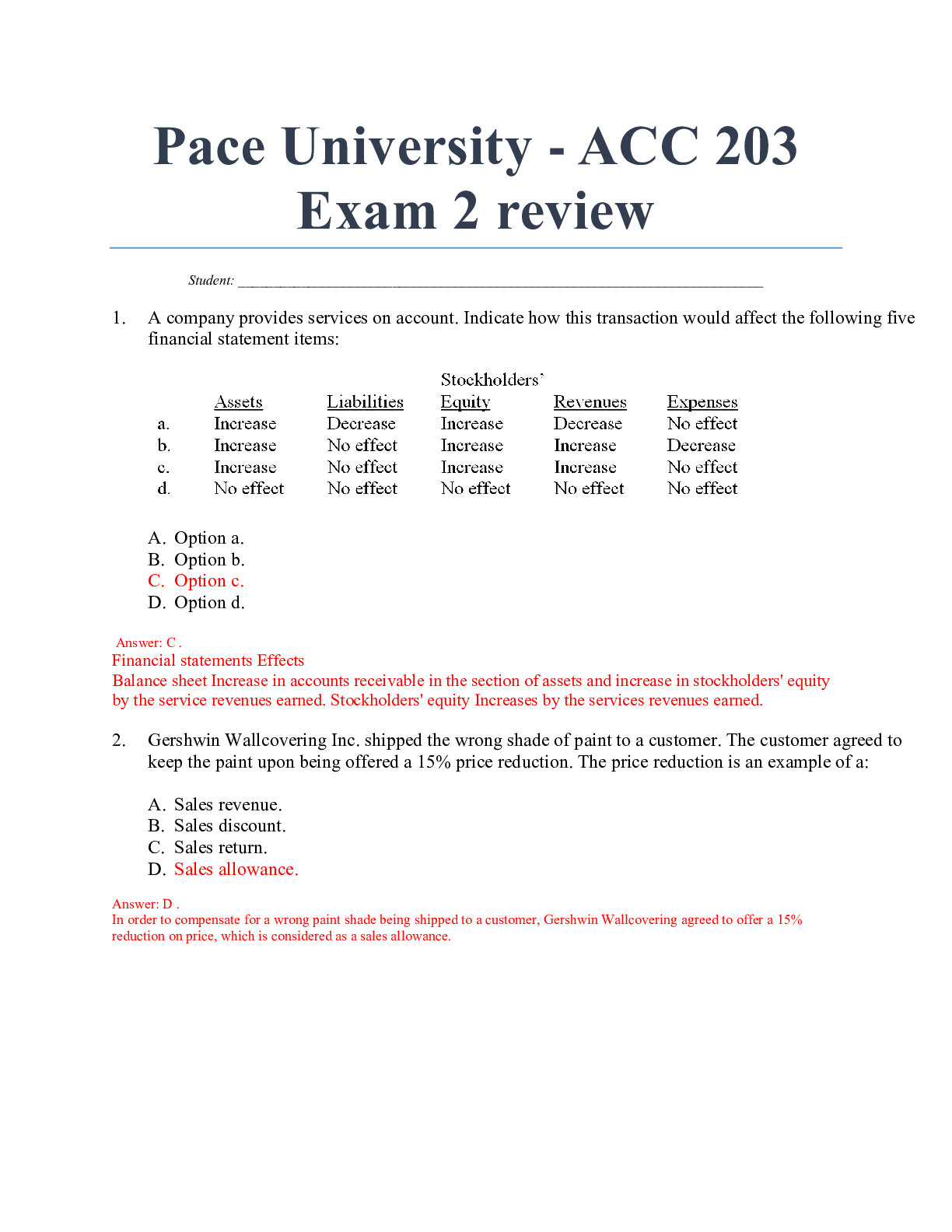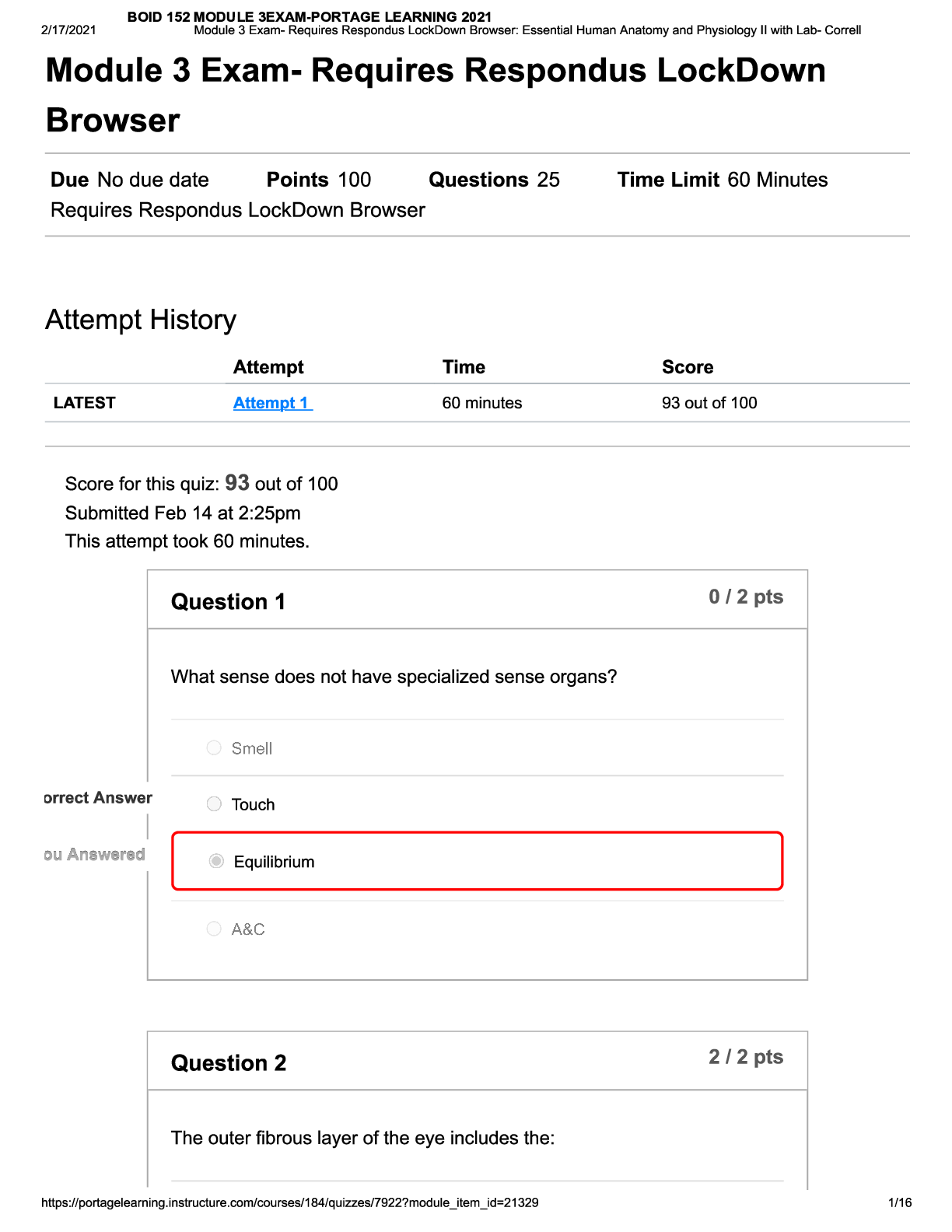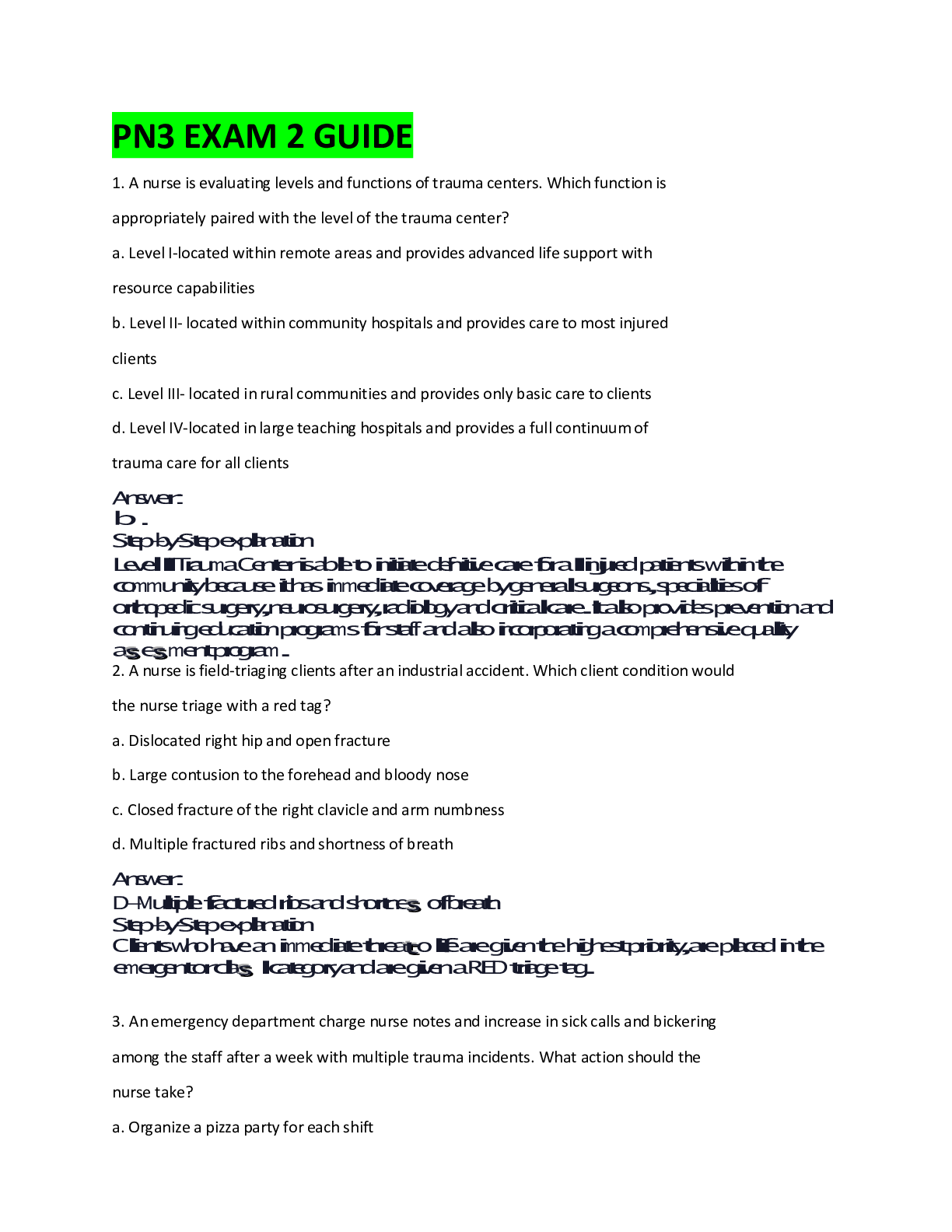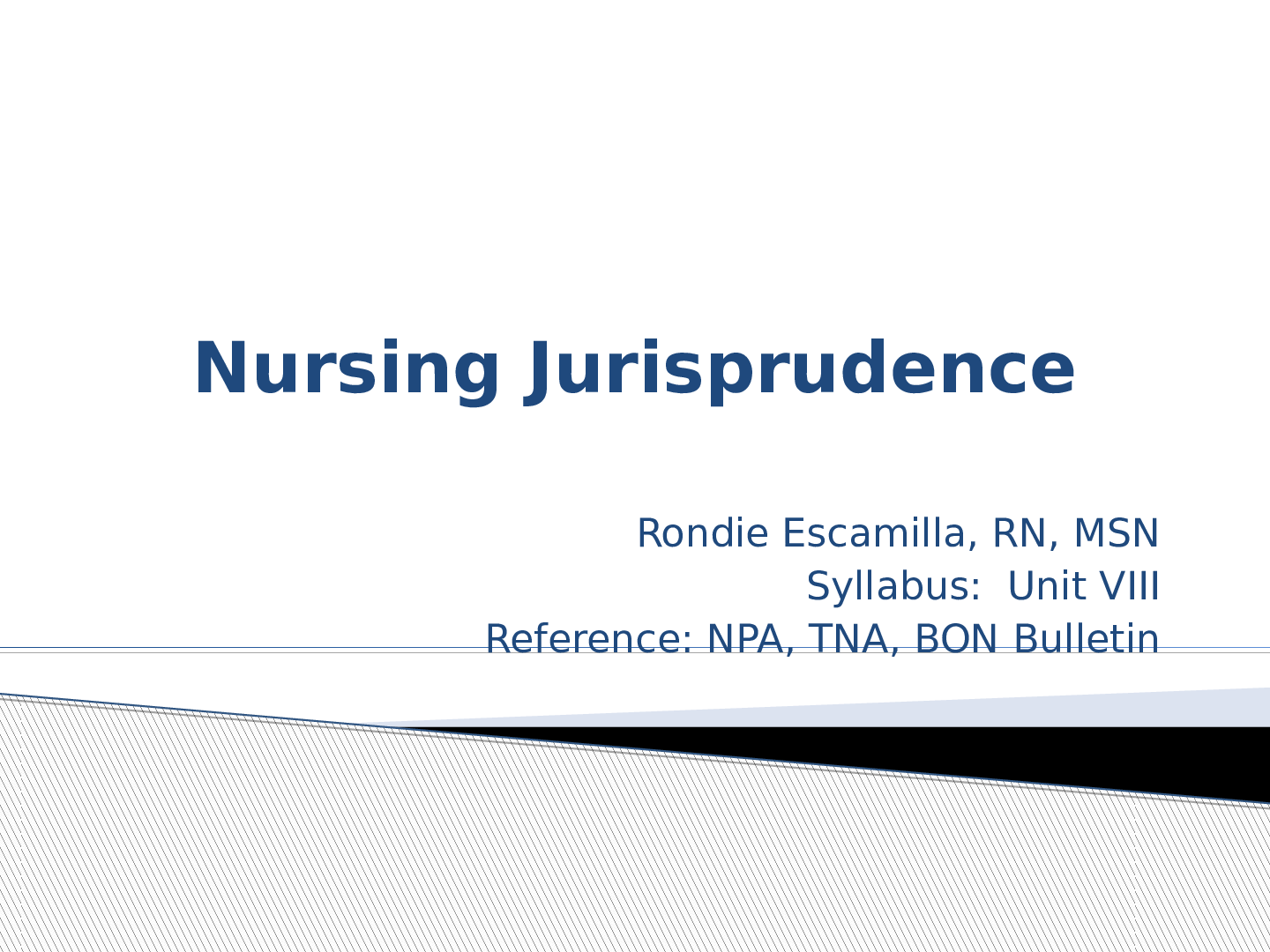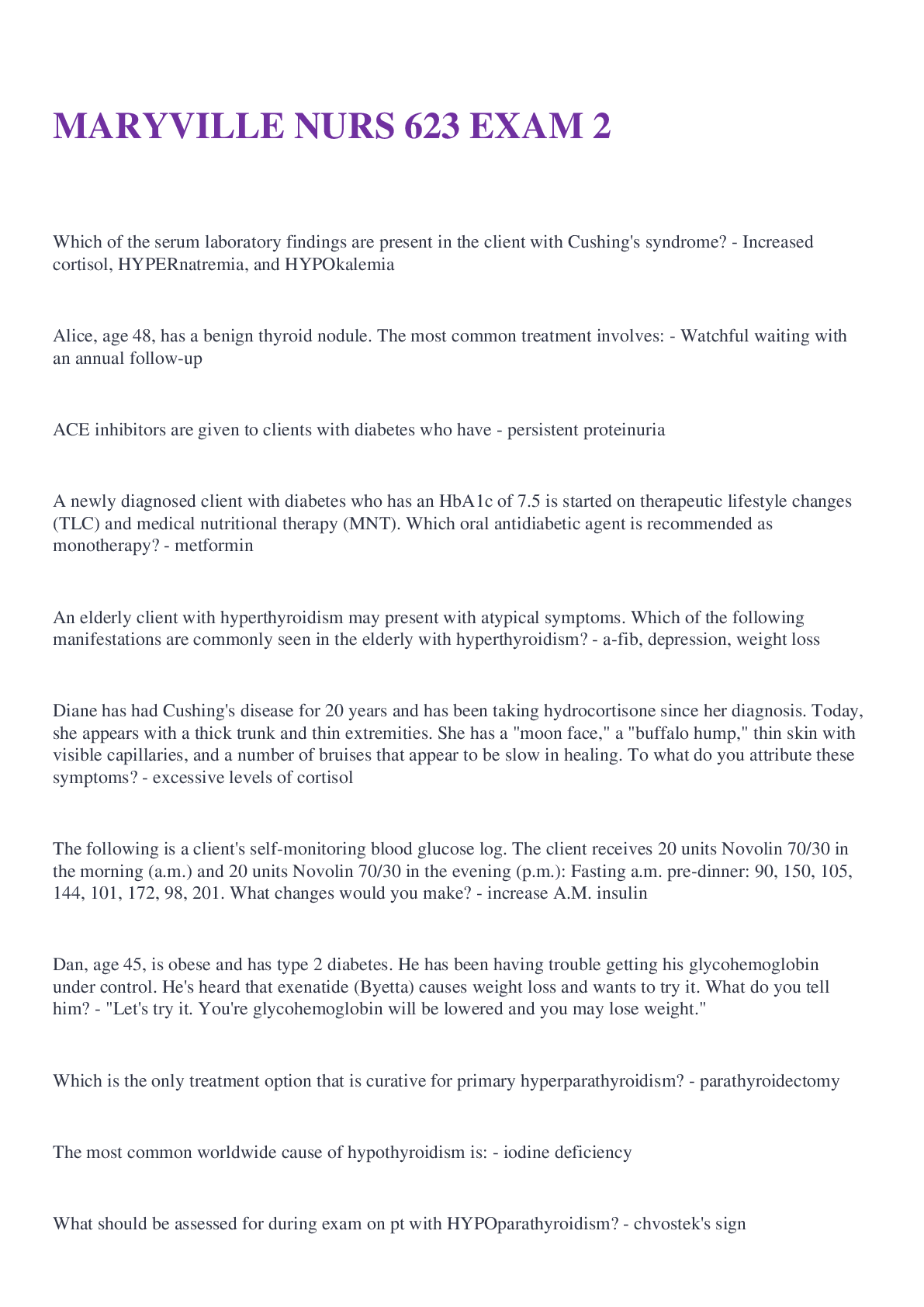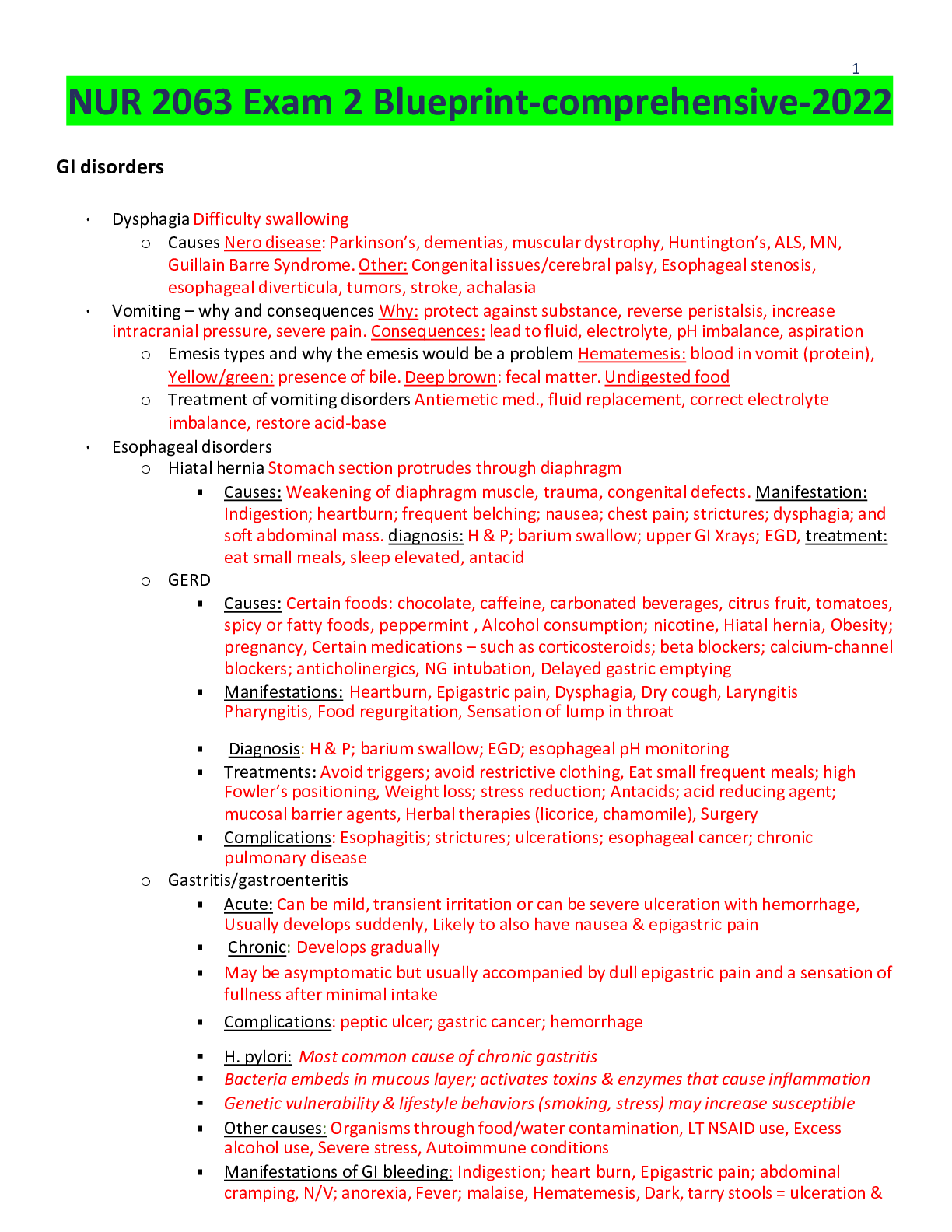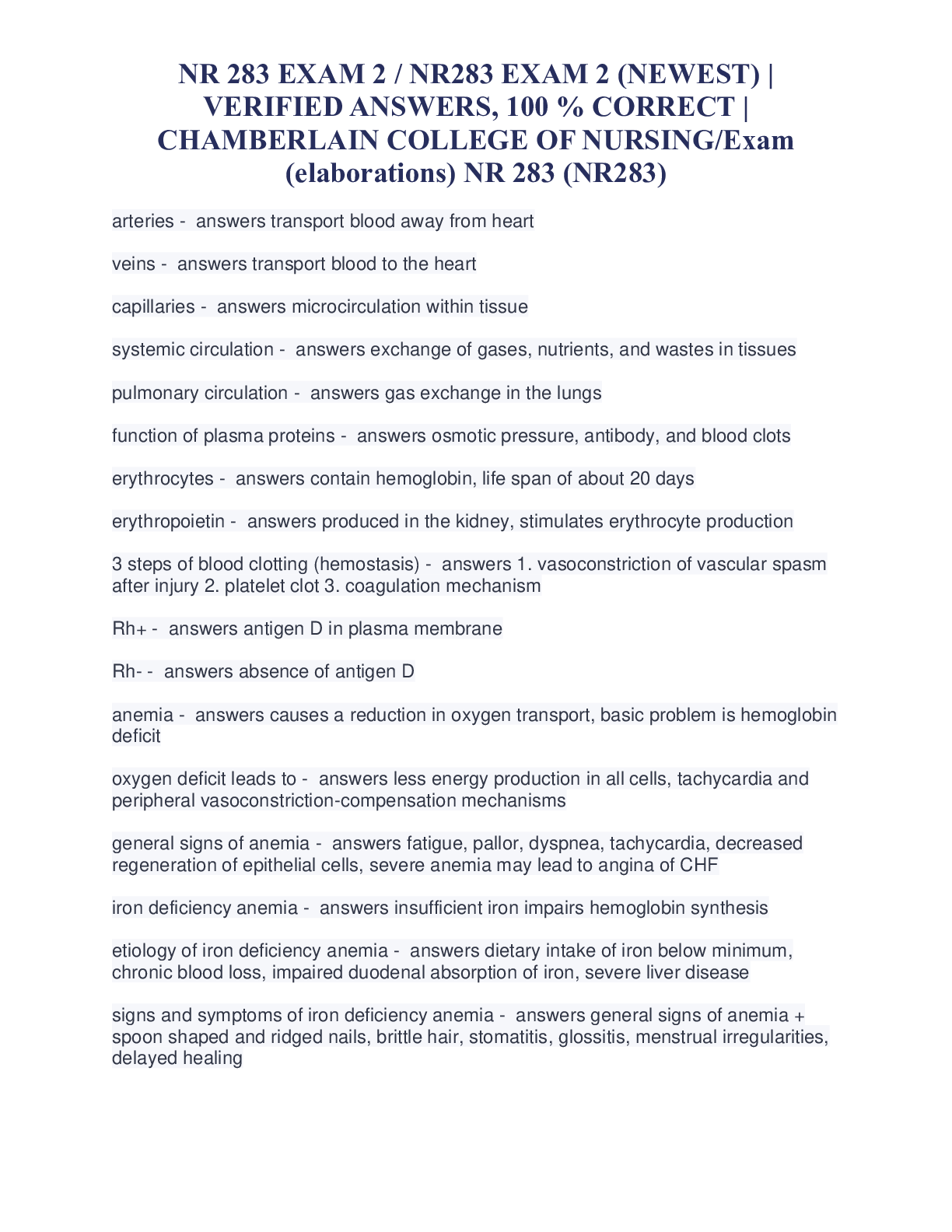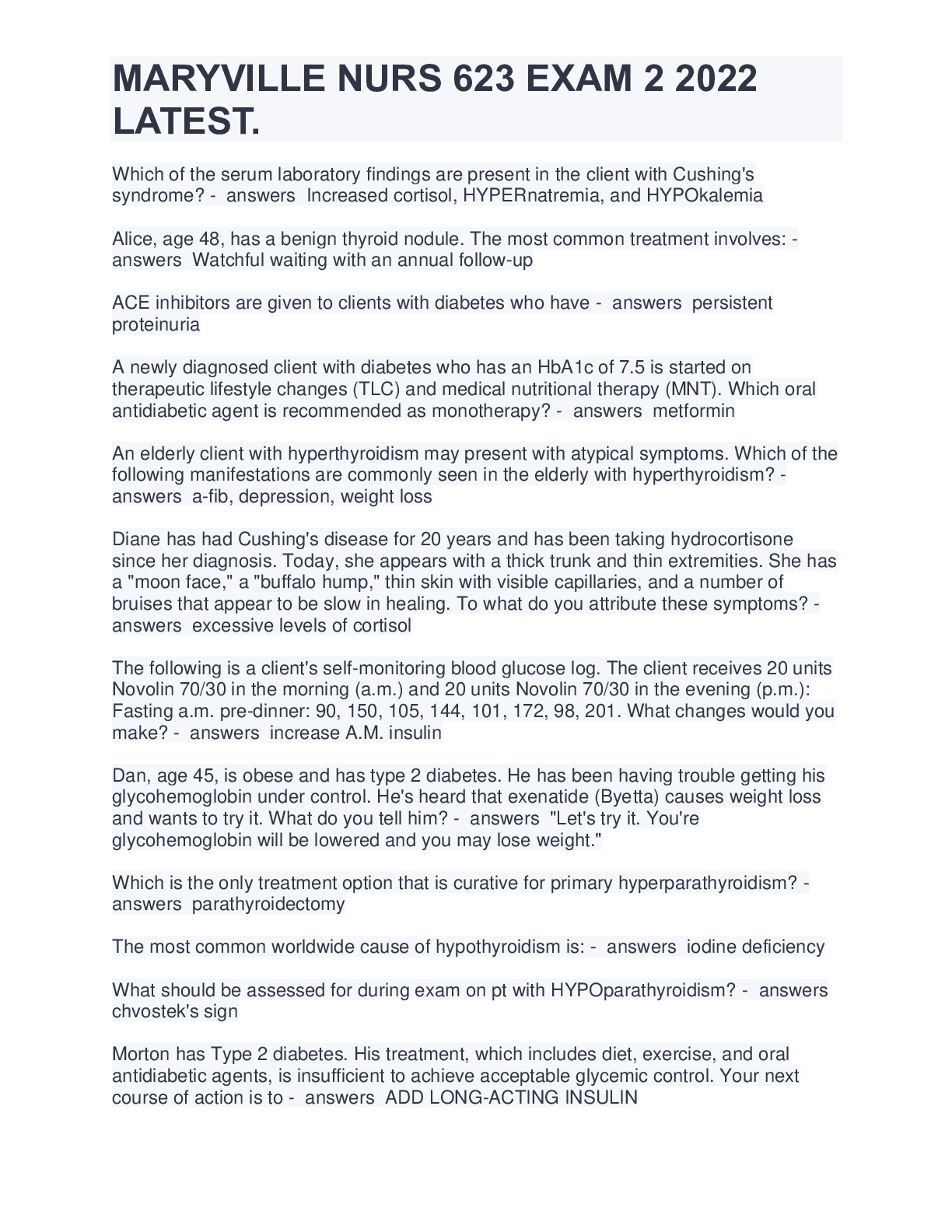*NURSING > EXAM > Rasmussen College: NUR 2502 MDC 3 Exam 2 Study Guide: Modules 4, 5, and 6_LATEST 2021/2022,100% CORR (All)
Rasmussen College: NUR 2502 MDC 3 Exam 2 Study Guide: Modules 4, 5, and 6_LATEST 2021/2022,100% CORRECT
Document Content and Description Below
Rasmussen College: NUR 2502 MDC 3 Exam 2 Study Guide: Modules 4, 5, and 6_LATEST 2021/2022 Module 4 – Upper Respiratory Disorders Head & Neck • Assessment Findings o Pain o Lump in mouth, ... throat, or neck o Difficulty swallowing o Color changes in mouth or tongue to red, white, gray, dark brown, or black o Oral lesions or sore that does not heal in 2 weeks o Persistent or unexplained oral bleeding o Numbness of the mouth, lips, face o Change in the fit of dentures o Burning sensation when drinking citrus juices or hot liquids o Persistent or recurrent sore throat o Shortness of breath o Anorexia & weight loss • Treatment o Radiation therapy o Chemotherapy o Biotherapy o Laryngectomy o Tracheotomy o Oropharyngeal cancer resection • Nursing Care o Maintaining a patent airway by suctioning the patient. o Monitor patient for complications of surgery such as hemorrhage, airway obstruction, wound breakdown, and possible infection. o Implement nutritional support to meet the patient’s needs. A feeding tube is generally inserted at the time of surgery to provide nutritional support since oral intake is not possible. o Consult speech and language pathologist to assist patient with communication needs. Nasal Fractures • Assessment Findings o Bruising o Pain o Nasal deviation o Crepitus o Blood or clear fluid draining (CSF) from the nose Epistaxis – Position pt. upright and leaning forward • Causes o Trauma o Hypertension o Leukemia o Inflammation o Tumor o Decreased humidity o Nose blowing/picking o Chronic cocaine use o Nasal procedure • Diagnostics o X-ray (to rule out disorders of the nose) • Assessment Findings o Nose bleeding/discharge • Treatment o Capillary cauterization o Silver nitrate o Electrocautery o Nasal packing o Epistaxis catheters • Nursing Interventions o Management of bleeding by applying direct lateral pressure to the nose for 10 minutes and application of ice or cool compresses. If bleeding does not cease, nasal packing may be applied. o Implement standard precautions. o Educate the patient to maintain an upright position, such as leaning forward to prevent aspiration. o Monitor blood pressure to prevent periods of hypertension, which could increase the chance of bleeding. o Instruct the patient not to blow his or her nose for 24 hours to prevent clot disruption. Facial Trauma • Assessment Findings o Stridor o SOB o Dyspnea o Anxiety o Restlessness o Hypoxia o Hypercarbia o Decreased O2 saturation o Cyanosis o Loss of consciousness o Pain o Discharge from nose and ears o Bruising Sleep Apnea - Obstructive sleep apnea (OSA) is a condition in which the patient experiences cyclical patterns of breathing disruption for periods of 10 seconds that occurs at least five times in an hour due to upper airway obstruction. • Causes o Obesity o Large uvula o Short neck o Smoking o Enlarged tonsils or adenoids o Oropharyngeal edema • Treatment o Noninvasive positive-pressure ventilation o BiPAP o Auto-titrating positive airway pressure (APAP) o CPAP o Tracheostomy Upper Airway Obstruction • Diagnosis o Sleep study • Assessment Findings o Diaphoresis o Tachycardia o Elevated blood pressure o Anxiety o Sternal retractions o Stridor o Cyanosis o Changes in level of consciousness • Treatment o Cricothyroidotomy - placing a tube through an incision in the cricothyroid membrane o Endotracheal intubation o Tracheotomy o Removal of obstruction • Multidimensional Care o Heimlich maneuver o Insert oral airway o Reposition head o Suction and abdominal thrusts Module 5- Lower Respiratory Disorders Asthma • Treatment o Avoid triggers o Medication ▪ Short acting: Albuterol, Levalbuterol. ▪ Long acting, not immediate: Salmeterol, Indacaterol o Reduce stress o Oxygen therapy o Regular exercise Emphysema - loss of lung elasticity and hyperinflation of the alveoli sacs due to trapped air. • Assessment Findings o Congestion o Wheezing o Dyspnea o Weight loss o Barrel chest o Finger clubbing o Cyanosis o Tachypnea o Jugular vein distention o Peripheral edema Chronic Bronchitis • Assessment Findings o Productive cough o Dyspnea o Pursed-lip breathing o Cyanosis o Use of accessory muscles o Tachypnea o Pedal edema o Weight gain o JVD o Stridor o Fever o Ronchi o Wheezing Cystic Fibrosis • Diagnosis o Sweat test – measure chloride levels in the sweat o Pulmonary function test o Chest x-ray o ABG • Assessment Findings o Wheezing o Dyspnea o Tachypnea o Barrel chest o Distended abdomen o Crackles o Clubbing of the fingers and toes o Dry non-productive cough o Foul-smelling pale stool w/ fat content o Hematemesis o Poor growth • Treatment o Nutrition management ▪ Weight maintenance, ▪ Vitamin supplementation, ▪ Diabetes management ▪ Pancreatic enzyme replacement o Positive expiratory pressure o Chest physiotherapy o Medications ▪ Bronchodilators ▪ Anti-inflammatories ▪ Antibiotics ▪ Mucolytics o O2 therapy o Lung transplant Pulmonary Fibrosis • Assessment Findings o Dyspnea o Weight loss o Fatigue • Treatment o Medication therapy ▪ Immunosuppressants • Cytotoxic drugs o cyclophosphamide (Cytoxan, Neosar, Procytox) o azathioprine (Imuran) o chlorambucil (Leukeran) o methotrexate (Folex) ▪ Corticosteroids o O2 therapy o Hospice o Palliative care • Multidimensional Care o Administer O2 and medications as prescribed o Prep for lung transplant o Monitor respiratory infections o Community resources o Provide information regarding hospice care Pulmonary Hypertension • Assessment Findings o Dyspnea o Fatigue o Angina o Lightheadedness o Edema o JVD • Treatment o Medication therapy ▪ Endothelin-receptor agonist: reduce blood vessel relaxation and decrease pulmonary arterial pressure • Warfarin (Coumadin) • Bosentan (Traxcleer) • macitentan (Opsumit) ▪ prostacyclin agents: reduce pulmonary pressure • Iloprost (Ilomedin, Ventavis, Ventavis) • treprostinil (Tyvaso) o Oxygen therapy o Treat underlying cause • Multidimensional Care o Administration of medications o O2 administration o Assists with placement of pulmonary artery catheter o Prep for surgery Lung Cancer • Diagnosis o Sputum culture – assess for abnormal cells o CBC o Liver function test – assess for metastasis o Chest x-ray o ABG o CT o Thoracoscopy o Pulmonary function test o PET-CT • Assessment Findings o Dyspnea o Use of accessory muscles to breathe o Weight loss o Wheezing o Pleural friction rub o Enlarged lymph nodes o Hemoptysis o Fatigue • Treatment o Chemotherapy o Targeted drug therapy o Symptom management o Oxygen therapy o Thoracotomy w/ partial lung removal o Hospice o Palliative care • Multidimensional Care o Administer antiemetics and proper skincare o Prep for surgery o Monitor respiratory status o Assess for bleeding and infection o Chest tube management o Pain management o Assist with coughing and deep breathing to prevent post-op complications Module 6 – Infectious Respiratory Disorders Seasonal Influenza • Assessment Findings o Severe headache o Muscle aches o Fever o Chills o Fatigue o Weakness o Sore throat o Cough o Watery nasal drainage • Treatment o Antiviral medication ▪ Oseltamivir (Tamiflu) ▪ zanamivir (Relenza) ▪ peramivir (Rapivab) o Rest o Increase fluid intake o Saline gargles o Antihistamines o Supportive care o Isolation precautions (airborne, droplet, contact) Pandemic Influenza • Assessment Findings o Cough o Fever o Sore throat o Diarrhea o Vomiting o Abdominal pain o Bleeding from the nose or gums • Treatment o Antiviral medication ▪ Oseltamivir (Tamiflu) ▪ zanamivir (Relenza) ▪ peramivir (Rapivab) o Rest o Increase fluid intake o Saline gargles o Antihistamines o Supportive care o Isolation precautions (airborne, droplet, contact) Middle East Respiratory Syndrome • Assessment Findings o Cough o SOB o Fever o Pneumonia o Diarrhea • Treatment o Supportive care to manage the symptoms o O2 therapy o Mechanical ventilation Pneumonia • Assessment Findings o Chest pain o Myalgia o Headache o Chills o Fever o Tachycardia o Cough o Dyspnea o Hemoptysis • Treatment o O2 therapy o Incentive spirometry o Bronchodilators o Steroids o Expectorants o Antibiotics o Sepsis prevention Pulmonary Tuberculosis • Assessment Findings o Unintentional weight loss o Anorexia o Night sweats o Hemoptysis o SOB o Chills o Fatigue o Nausea o Fever • Treatment o Antimicrobial therapy ▪ Isoniazid (NH, Nidrazid) ▪ Rampin (Rifadin) ▪ Pyrazinaminde ▪ Ethambutol (Myambutol) o Isolation precautions (airborne) Rhinosinusitis • Diagnosis o Endoscopic examination o CT scan o Patient assessment • Assessment Findings o Nasal discharge o Fever o Headache o Fatigue o Nasal congestion o Facial o Ear pressure • Treatment o Medications ▪ Amoxicillin ▪ Phenylephrine (Neo-Synephrine) ▪ Antipyretics o Surgery to relieve obstruction and drainage Peritonsillar Abscess • Assessment Findings o Sore throat o Difficulty swallowing o Difficulty breathing o Bad breath o Lymph node enlargement • Treatment o Antibiotics o Steroids o Pain control o Tonsillectomy Inhalation Anthrax • Assessment Findings o Fever o Fatigue o Mild chest pain o Dry cough o Dyspnea • Treatment o Ciprofloxacin (Cipro) o Doxycycline (Vibramycin) o Amoxicillin (Amaxil, Trimax) o Rifampin o Clindamycin or vancomycin Pertussis • Assessment Findings o Cough o Diminished breath o Vomiting o Nasal discharge o Fever o Fatigue • Treatment o Droplet precautions o Supportive care o O2 therapy o Antibiotics ▪ Azithromycin (Zithromax) ▪ Clarithromycin (Biaxin) ▪ erythromycin Coccidioidomycosis • Diagnosis o Chest x-ray • Assessment Findings o Fever o Hemoptysis o Wheezing o Diminished breath sounds • Treatment o Supportive care o Antifungal Medications ▪ Fluconaxzole (Diflucan) ▪ Ketoconazole (Nizoral) ▪ Voriconazole (Vfend) Nursing care for all infectious respiratory disorders • Performing hand hygiene to prevent the spread of infection • Administration of prescribed vaccinations • Administration of medications to treat the disorder • Implementation of required isolation precautions • Performing a focused respiratory assessment • Administration of oxygen as prescribed • Encouraging coughing and deep breathing • Monitoring vital signs to include pulse oximetry • Monitoring of laboratory and diagnostic tests • Ensuring adequate nutritional intake [Show More]
Last updated: 1 year ago
Preview 1 out of 14 pages
Instant download

Instant download
Reviews( 0 )
Document information
Connected school, study & course
About the document
Uploaded On
Feb 25, 2022
Number of pages
14
Written in
Additional information
This document has been written for:
Uploaded
Feb 25, 2022
Downloads
0
Views
53






